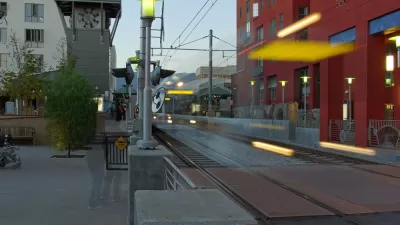Advocates for a more multi-modal lifestyle in Los Angeles have achieved tremendous successes in the last decade. But ongoing bike lane controversies shows there's still a long way to go.
Advocates for complete streets and a more multi-modal lifestyle in Los Angeles have achieved tremendous successes in the last decade. But ongoing controversies about bike lanes shows there's still a long way to go.
Drew Reed begins a recent article for Citymetric by noting that Los Angeles residents have grown more supportive of alternative modes of transportation, citing the ambitious rail build-out enabled by the half-cent sales tax approved by Measure R as an example. Yet, when it comes to bike lanes, a less auto-centric vision for transportation has been harder to implement, with about 200 miles built out of a plan that calls for 1,684 miles of bike infrastructure.
Reed cites the example a proposed, now defunct, bike lane in Northeast Los Angeles as an example of the dysfunction that still surrounds complete streets planning in Los Angeles. "The planned bike lane for Figueroa in Northeast Los Angeles has become a case study in exactly how much can go wrong with a seemingly good plan. In documents released in 2010, the area was listed as a priority." That after Councilmember Gil Cedillo pulled the plug on the lane, claiming that the bike lane would impede the ability of emergency vehicles to navigate the street.
Reed compares that example with that of the MyFigueroa project, which would add a protected bike lane, among other complete streets improvements, on a stretch of Figueroa Street located south of Downtown Los Angeles. That project recently passed sizable hurdles in the form of wealthy, landowning businesses located along route of the proposed complete streets project.
FULL STORY: Los Angeles: A Tale of Two Bike Lanes

Alabama: Trump Terminates Settlements for Black Communities Harmed By Raw Sewage
Trump deemed the landmark civil rights agreement “illegal DEI and environmental justice policy.”

Planetizen Federal Action Tracker
A weekly monitor of how Trump’s orders and actions are impacting planners and planning in America.

How Atlanta Built 7,000 Housing Units in 3 Years
The city’s comprehensive, neighborhood-focused housing strategy focuses on identifying properties and land that can be repurposed for housing and encouraging development in underserved neighborhoods.

In Both Crashes and Crime, Public Transportation is Far Safer than Driving
Contrary to popular assumptions, public transportation has far lower crash and crime rates than automobile travel. For safer communities, improve and encourage transit travel.

Report: Zoning Reforms Should Complement Nashville’s Ambitious Transit Plan
Without reform, restrictive zoning codes will limit the impact of the city’s planned transit expansion and could exclude some of the residents who depend on transit the most.

Judge Orders Release of Frozen IRA, IIJA Funding
The decision is a victory for environmental groups who charged that freezing funds for critical infrastructure and disaster response programs caused “real and irreparable harm” to communities.
Urban Design for Planners 1: Software Tools
This six-course series explores essential urban design concepts using open source software and equips planners with the tools they need to participate fully in the urban design process.
Planning for Universal Design
Learn the tools for implementing Universal Design in planning regulations.
Caltrans
Smith Gee Studio
Institute for Housing and Urban Development Studies (IHS)
City of Grandview
Harvard GSD Executive Education
Toledo-Lucas County Plan Commissions
Salt Lake City
NYU Wagner Graduate School of Public Service



























